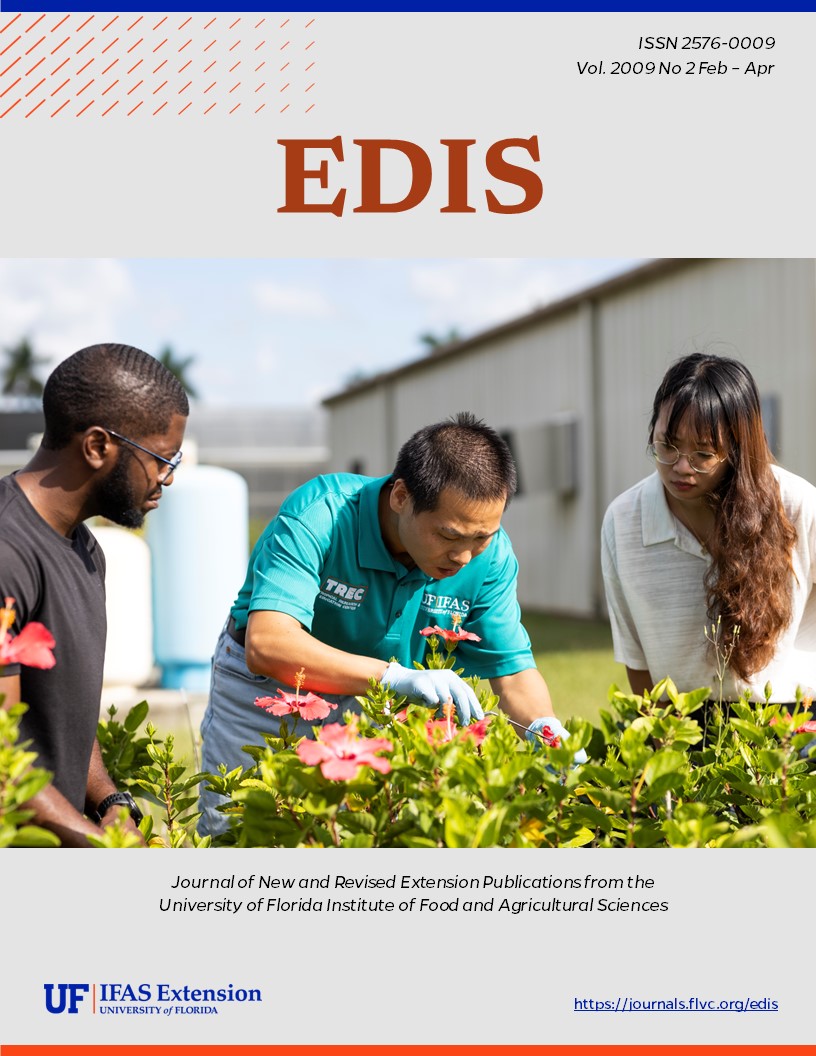Abstract
EENY-445, a 6-page illustrated fact sheet by Margaret Pfiester and Phillip E. Kaufman, is part of the Featured Creatures collection. It describes this hover fly that mimics the European honey bee and is adapted to living in polluted habitats — its distribution, description, life cycle, economic importance, and management. Includes references. Published by the UF Department of Entomology and Nematology, March 2009.
References
Aguilera A, Cid A, Regueiro BJ, Prieto JM, Noya M. 1999. Intestinal myiasis caused byEristalis tenax. Journal of Clinical Microbiology 37: 3082. https://doi.org/10.1128/JCM.37.9.3082-3082.1999
Bates HW. 1862. Contributions to an insect fauna of the Amazon valley. Lepidoptera: Heliconidae. Transactions of the Linnean Society 23: 495-566. https://doi.org/10.1111/j.1096-3642.1860.tb00146.x
Brower JZ, Brower LP. 1965. Experimental studies of mimicry. 8. Further investigations of honeybees (Apis mellifera) and their dronefly mimics (Eristalis spp.). The American Naturalist 99: 173-187. https://doi.org/10.1086/282365
Capinera JL. 2004. Flies. pp. 875-883. In Encyclopedia of Entomology, Vol. 2. Capinera JL [ed.]. Kluwer Academic Publishers, Dordrecht, The Netherlands.
Catts EP, Mullen GR. 2002. Myiasis (Muscoidea, Oestroidea). pp. 319-348. In Mullen G, Durden L [eds.], Medical and Veterinary Entomology. Academic Press an Imprint of Elsevier, San Diego, CA. https://doi.org/10.1016/B978-012510451-7/50018-9
Day ER. (2008). Livestock area fly control. Virginia Tech Extension. https://ext.vt.edu/pubs/pmg/fc/LivestockAreaFlyControl.pdf (5 February 2009).
Gilbert FS. 1986. Hoverflies. Cambridge University Press, Cambridge, England.
Golding YC, Ennos AR, Edmunds M. 2001. Similarity in flight behaviour between the honeybee Apis mellifera (Hymenoptera: Apidae) and its presumed mimic, the dronefly Eristalis tenax (Diptera: Syrphidae). The Journal of Experimental Biology 204: 139-145. https://doi.org/10.1242/jeb.204.1.139
Heal J. 1979. Colour patterns of Syrphidae II. Eristalis intricarius. Heredity 43: 229-238. https://doi.org/10.1038/hdy.1979.78
Herms WM. 1969. Herms's Medical Entomology 6th ed. James MT, Harwood RF [eds.], The Macmillan Company, London, England.
Ibrahim IA, Gad AM. 1978. The occurrence of paedogenesis in Eristalis larvae (Diptera, Syrphidae). Journal of Medical Entomology 12: 268. https://doi.org/10.1093/jmedent/12.2.268
Ilse D. 1949. Colour discrimination in the drone fly Eristalis tenax. Nature 163: 255-256. https://doi.org/10.1038/163255a0
Kaufman PE, Rutz DA, Waldron JK. (2000). Common pest flies found in the urban/rural environment and their biological control agents. IPM Fact Sheet 1021PMFS1. Cornell Cooperative Extension. http://entomology.cornell.edu/Extension/Vet/PDF_Files/Common_pest_fly_factsheet.pdf (5 February 2009).
Kendall DA, Stradling DJ. 1972. Some observations on the overwintering of the dronefly, Eristalis tenax (L.) (Syrphidae). Entomologist 105: 229-230.
Lakshminarayana CS, Kanchana MV, Janakavalli R, Mallika M. 1975. Intestinal myiasis due to Eristalis tenax. Journal of the Indian Medical Association 65: 234-235.
Lyon WF. (1995). Livestock and livestock building pest management bulletin 473. Rattailed maggots (Syrphid fly larvae). Ohio State Bulletin. http://ohioline.osu.edu/b473/b473_21.html (5 February 2009).
Metcalf CL. 1913. The Syrphidae of Ohio. Ohio State University Bulletin 17: 1-123.
Milne L, Milne M. 1980. The Audubon Society field guide to North American insects and spiders. Alfred A. Knopf, Inc., New York, NY.
Osten-Sacken CR. 1893. On the oxen-born bees of the ancients (Bugonia), and their relation to Eristalis tenax, a two-winged insect. Bullettino della Societa Entomologica Italiana 25: 186-217.
Rogers JS, Walker FW. 1916. Syrphidae of Maine. Maine Experimental State Bulletin 253.
Thompson CE. (1999). Flower Flies. United States Department of Agriculture, The Diptera Site. http://www.sel.barc.usda.gov/diptera/syrphid/syrphid.htm (5 February 2009).
Weems HV. 1951. Check list of the syrphid flies (Diptera: Syrphidae) of Florida. Florida Entomologist 34: 89-113. https://doi.org/10.2307/3492021
Weems HV. (2004). A hover fly, Allograpta obliqua (Say). Featured Creatures. http://entomology.ifas.ufl.edu/creatures/beneficial/hover_fly.htm (5 February 2009). https://doi.org/10.32473/edis-in342-2004
Wellington WG, Fitzpatrick, SM, 1981, Territoriality in the dronefly. Eristalis tenax (L.) (Syrphidae). Canadian Entomologist 1113: 695-704 https://doi.org/10.4039/Ent113695-8

